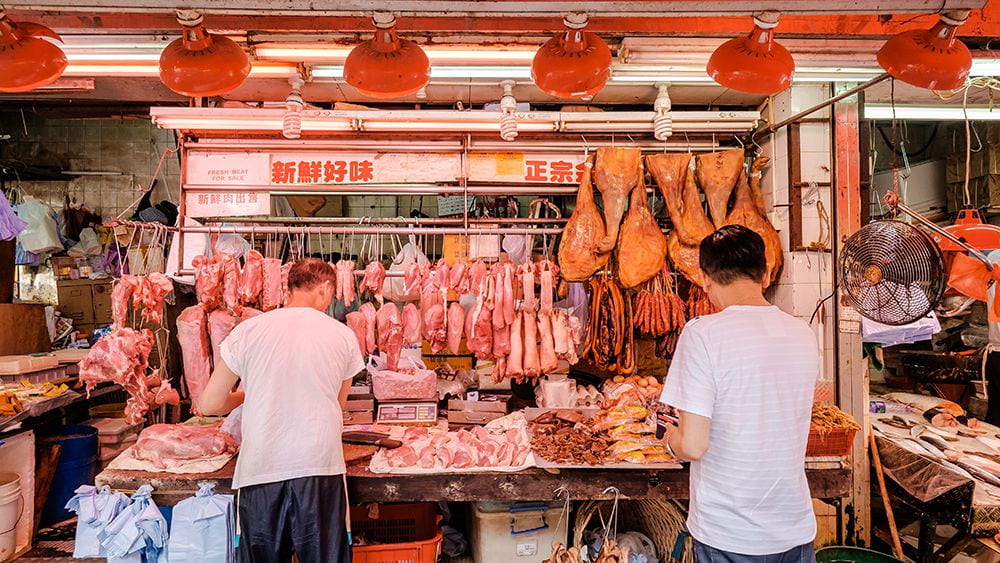Lauren Malte is a rising junior majoring in public health at the University of Arkansas. Born and raised in the Philippines, Lauren has taken a keen interest in studying diverse cultural health perspectives and hopes to one day have a career dedicated to global health and epidemiology. After completing a bachelor’s degree in public health, Lauren plans on attending medical school to become an infectious disease physician. In this post, she responds to a lecture led by UA biology professor Kristian Forbes, Spillover of Wildlife Pathogens.
Growing up, my grandmother bought meat from wet markets. She would not shop for the pre-packaged meat at the grocery store, which in her judgement, is not as good as meat butchered right in front of you on a tile countertop. As a little girl, I never wanted to go with her to the wet market. They were smelly places, and the sight of animals being chopped up with huge knives were a little bit too morbid for my young eyes. I remember seeing cows, pigs, chickens, and seafood butchered right in front of me, and they were enough to create a disturbing sight.
Wet markets are common all around the world, and for a long time, they have been the sites for slaughtering and butchering animals on the spot. However, in the Huanan Seafood Wholesale Market, a wet market in China, an exceptionally disturbing event occurred. Disease spilled over from wildlife to human, and a pandemic took the world by storm.
This made me wonder, what exactly set apart that Chinese wet market from the wet markets I often visited as a child in the Philippines? Why didn’t a disease spillover in other wet markets, as unsanitary as they are? Researchers say that the risk of disease transmission increases with the involvement of exotic wildlife, and the Huanan Seafood Wholesale Market, which sold exotic wildlife, created an ideal environment for viruses to mutate and effectively transmit from animal to human.
The process of spillover, which begins with the transmission of the virus to a human, is made possible due to a series of mutations. A biochemical and genetic study on SARS-CoV-2, the virus that causes COVID-19, noted that the virus mutated to have a receptor-binding domain (RBD) that binds with the human receptor ACE2. This came as a result of natural selection, which strongly suggests that SARS-CoV-2 was not purposefully engineered by humans. (“The Proximal Origin of SARS-CoV-2,” Nature Medicine 26, 450-452, 2020).
Upon analyzing the possible origin of COVID-19 and tracing its mutation process, in which the same series of mutations are likely to be repeated with other zoonotic transfers, we can more effectively prevent the emergence or re-emergence of future diseases. Considering that SARS-CoV-2 shares similarities with bat SARS-CoV-like coronaviruses, it is highly likely that bats are the reservoir hosts of the disease.
In comparison to human interaction with domesticated animals, we simply have not had a very long history of exposure to exotic wildlife and the viruses they carry. For that reason, humans are more susceptible to contracting novel diseases from wildlife, especially in locations of unusual and unfavorable contact. However, these spillovers from wildlife to mankind don’t happen all the time. If anything, they are rare occurrences. In a discussion with Dr. Kristian Forbes, he pointed out that there are bottlenecks involved with these mutations, narrowing the chances of spillover to a smaller number. However, they can still happen, and our actions are increasing the odds for spillover.
To prevent transmission from wildlife to humans, we must look beyond wet markets to the root of the problem: habitat destruction. Areas with high biodiversity, shrinking habitats and stressed wildlife harbor high risks of zoonotic disease spillover. We must protect these habitats with high biodiversity in order to maintain wildlife health, decrease human exposure, and ultimately decrease the risk of developing infections from wildlife, a common source of human disease.
Figuring out who to blame is a counterproductive approach. Dr. Forbes made sure to detail that in nature, we are all interconnected. To bring back the balance of our natural system, we must recognize and respect the limits of our natural resources. If our actions could be less disturbing, then we could experience less disturbances in return. We can do this if we modify the way we value our resources, and thus create harmony with nature’s economy.

